Comprehensive Report: Contemporary Issues and Growth in SME Management
VerifiedAdded on 2020/06/06
|9
|2872
|306
Report
AI Summary
This report provides a detailed analysis of Small and Medium-sized Enterprises (SMEs), covering various aspects of their management and development. It begins by defining SMEs and exploring contemporary challenges faced by these businesses, such as cash flow management, employee hiring, time management, marketing strategies, and funding issues, using RAHAT Ltd. as a case study. The report then delves into different growth strategies for SMEs, including globalization, strategic planning, and innovation. It also examines alternative methods for SME growth, such as training, government support, attracting investors, and creating uniqueness. Furthermore, the report evaluates various sources of finance available to SMEs, including internal and external sources like grants and bank overdrafts. It also discusses government policies aimed at supporting SME development, highlighting initiatives like business incubation, social security, technology upgrades, and tax regimes. Finally, the report addresses the issues of managing change within SMEs, considering both qualitative and structural changes, and their impact on business operations.
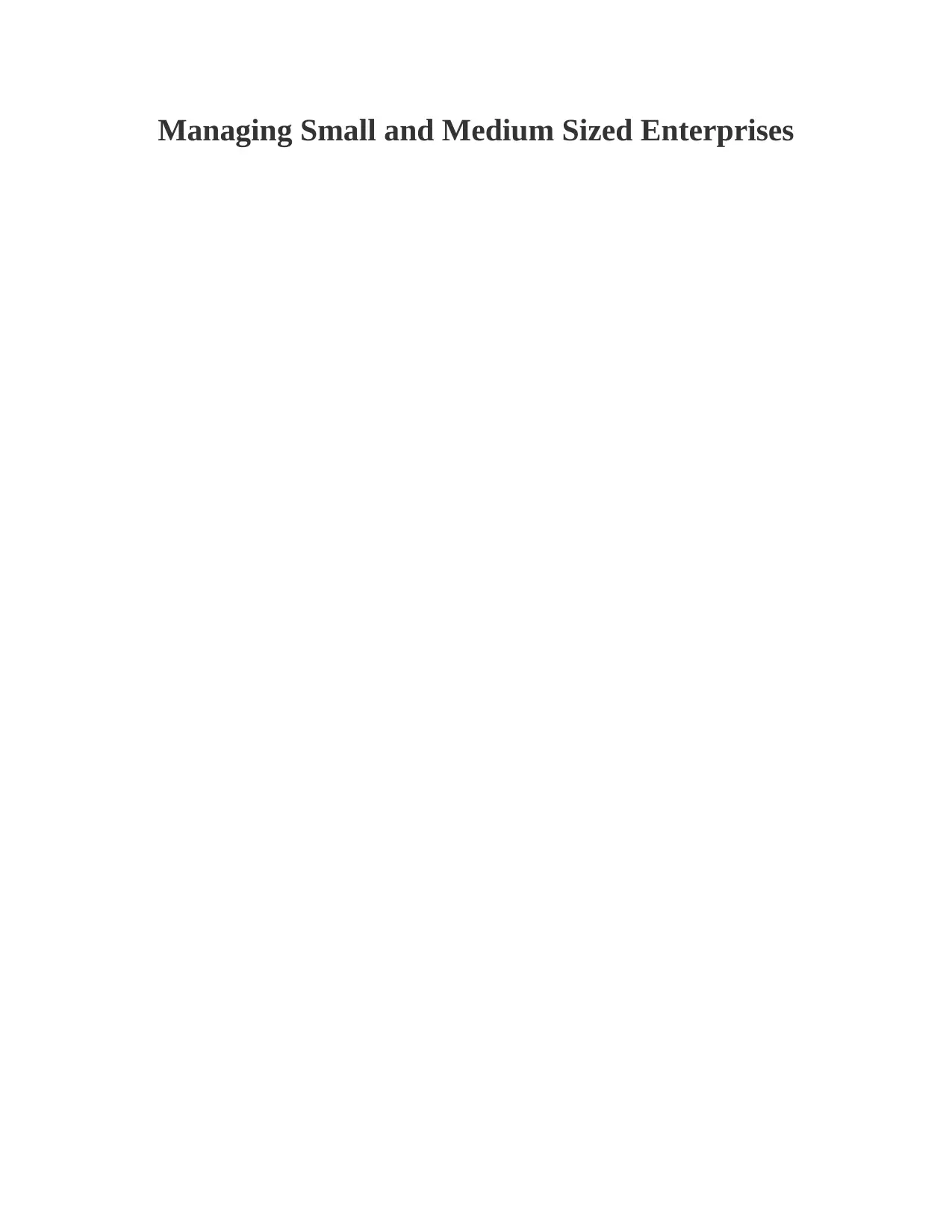
Managing Small and Medium Sized Enterprises
Paraphrase This Document
Need a fresh take? Get an instant paraphrase of this document with our AI Paraphraser
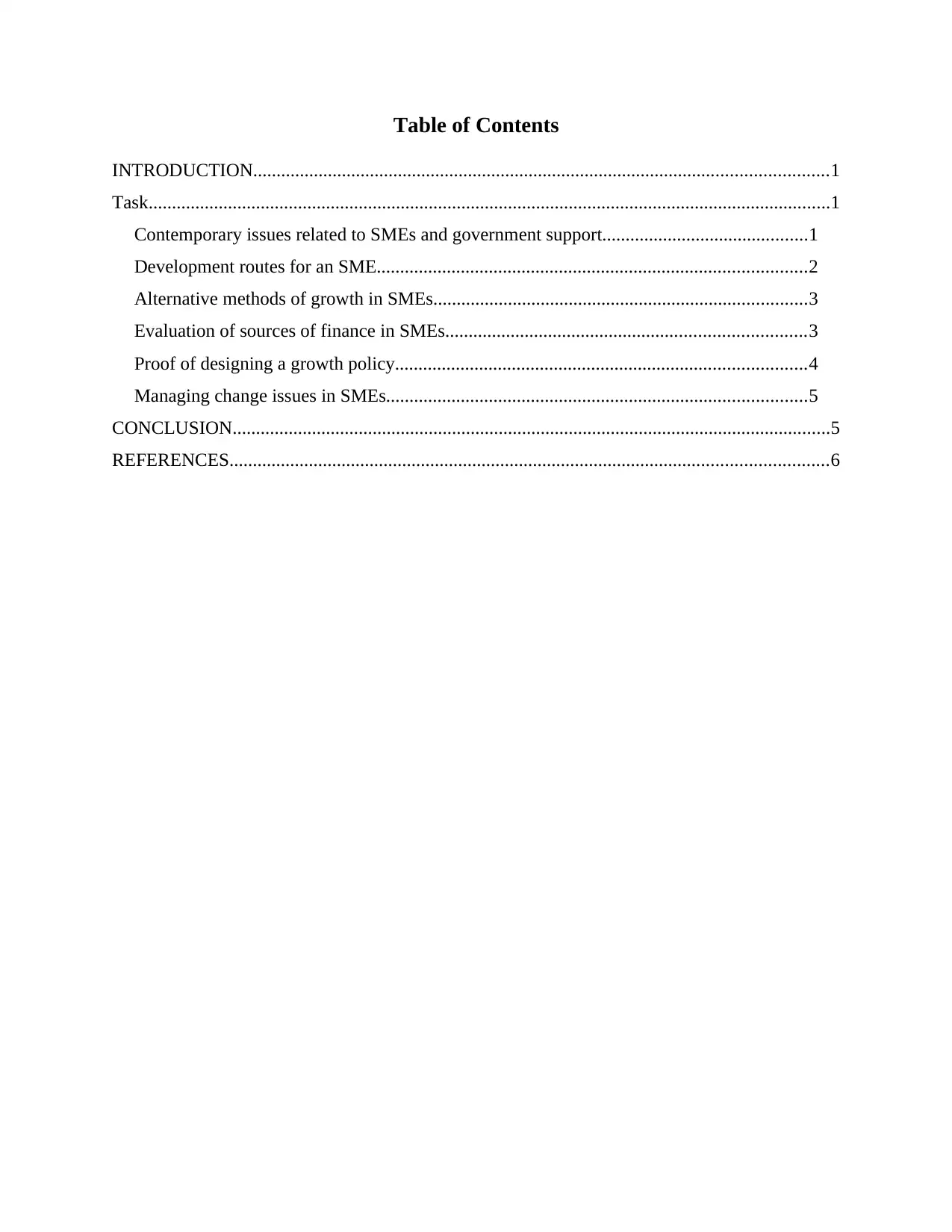
Table of Contents
INTRODUCTION...........................................................................................................................1
Task..................................................................................................................................................1
Contemporary issues related to SMEs and government support............................................1
Development routes for an SME............................................................................................2
Alternative methods of growth in SMEs................................................................................3
Evaluation of sources of finance in SMEs.............................................................................3
Proof of designing a growth policy........................................................................................4
Managing change issues in SMEs..........................................................................................5
CONCLUSION................................................................................................................................5
REFERENCES................................................................................................................................6
INTRODUCTION...........................................................................................................................1
Task..................................................................................................................................................1
Contemporary issues related to SMEs and government support............................................1
Development routes for an SME............................................................................................2
Alternative methods of growth in SMEs................................................................................3
Evaluation of sources of finance in SMEs.............................................................................3
Proof of designing a growth policy........................................................................................4
Managing change issues in SMEs..........................................................................................5
CONCLUSION................................................................................................................................5
REFERENCES................................................................................................................................6
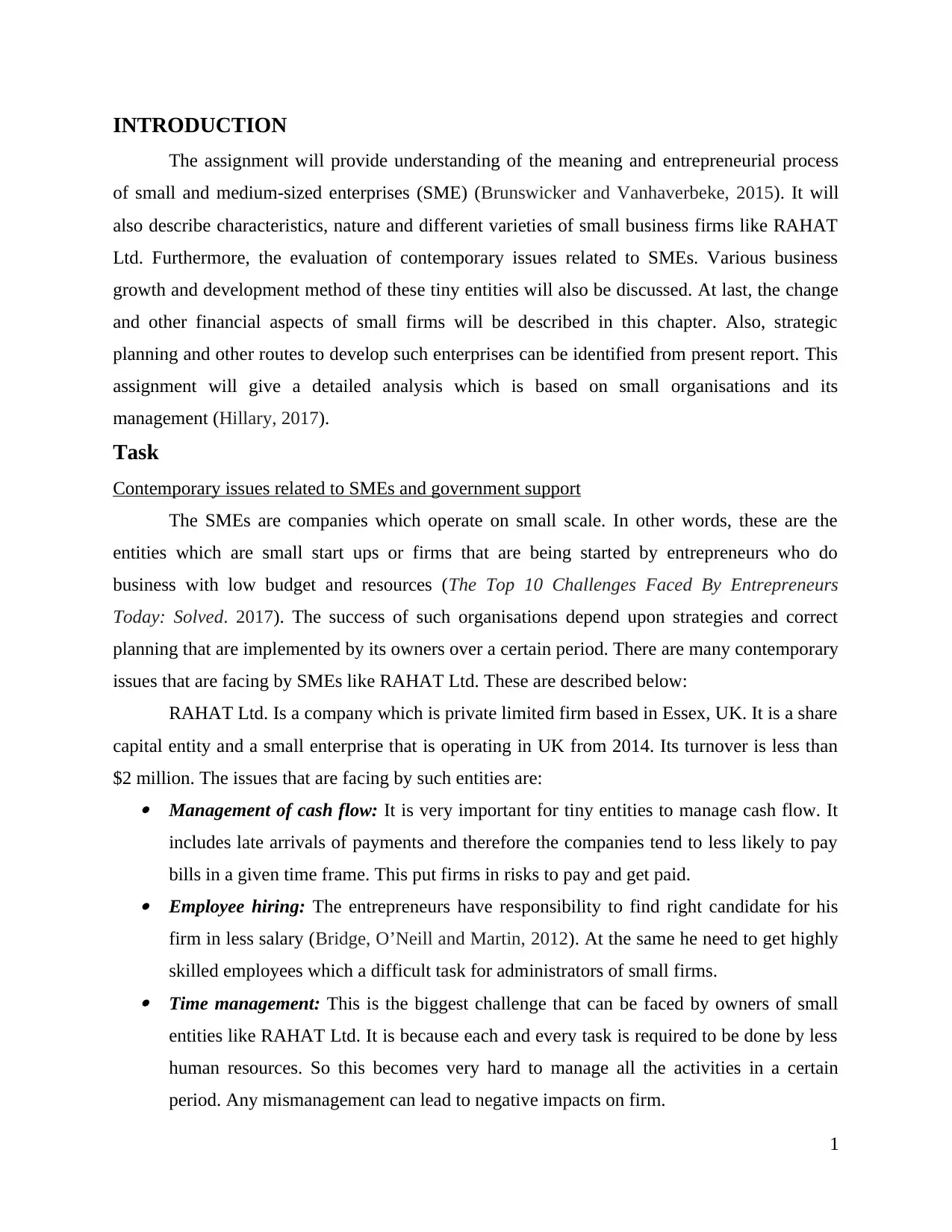
INTRODUCTION
The assignment will provide understanding of the meaning and entrepreneurial process
of small and medium-sized enterprises (SME) (Brunswicker and Vanhaverbeke, 2015). It will
also describe characteristics, nature and different varieties of small business firms like RAHAT
Ltd. Furthermore, the evaluation of contemporary issues related to SMEs. Various business
growth and development method of these tiny entities will also be discussed. At last, the change
and other financial aspects of small firms will be described in this chapter. Also, strategic
planning and other routes to develop such enterprises can be identified from present report. This
assignment will give a detailed analysis which is based on small organisations and its
management (Hillary, 2017).
Task
Contemporary issues related to SMEs and government support
The SMEs are companies which operate on small scale. In other words, these are the
entities which are small start ups or firms that are being started by entrepreneurs who do
business with low budget and resources (The Top 10 Challenges Faced By Entrepreneurs
Today: Solved. 2017). The success of such organisations depend upon strategies and correct
planning that are implemented by its owners over a certain period. There are many contemporary
issues that are facing by SMEs like RAHAT Ltd. These are described below:
RAHAT Ltd. Is a company which is private limited firm based in Essex, UK. It is a share
capital entity and a small enterprise that is operating in UK from 2014. Its turnover is less than
$2 million. The issues that are facing by such entities are: Management of cash flow: It is very important for tiny entities to manage cash flow. It
includes late arrivals of payments and therefore the companies tend to less likely to pay
bills in a given time frame. This put firms in risks to pay and get paid. Employee hiring: The entrepreneurs have responsibility to find right candidate for his
firm in less salary (Bridge, O’Neill and Martin, 2012). At the same he need to get highly
skilled employees which a difficult task for administrators of small firms. Time management: This is the biggest challenge that can be faced by owners of small
entities like RAHAT Ltd. It is because each and every task is required to be done by less
human resources. So this becomes very hard to manage all the activities in a certain
period. Any mismanagement can lead to negative impacts on firm.
1
The assignment will provide understanding of the meaning and entrepreneurial process
of small and medium-sized enterprises (SME) (Brunswicker and Vanhaverbeke, 2015). It will
also describe characteristics, nature and different varieties of small business firms like RAHAT
Ltd. Furthermore, the evaluation of contemporary issues related to SMEs. Various business
growth and development method of these tiny entities will also be discussed. At last, the change
and other financial aspects of small firms will be described in this chapter. Also, strategic
planning and other routes to develop such enterprises can be identified from present report. This
assignment will give a detailed analysis which is based on small organisations and its
management (Hillary, 2017).
Task
Contemporary issues related to SMEs and government support
The SMEs are companies which operate on small scale. In other words, these are the
entities which are small start ups or firms that are being started by entrepreneurs who do
business with low budget and resources (The Top 10 Challenges Faced By Entrepreneurs
Today: Solved. 2017). The success of such organisations depend upon strategies and correct
planning that are implemented by its owners over a certain period. There are many contemporary
issues that are facing by SMEs like RAHAT Ltd. These are described below:
RAHAT Ltd. Is a company which is private limited firm based in Essex, UK. It is a share
capital entity and a small enterprise that is operating in UK from 2014. Its turnover is less than
$2 million. The issues that are facing by such entities are: Management of cash flow: It is very important for tiny entities to manage cash flow. It
includes late arrivals of payments and therefore the companies tend to less likely to pay
bills in a given time frame. This put firms in risks to pay and get paid. Employee hiring: The entrepreneurs have responsibility to find right candidate for his
firm in less salary (Bridge, O’Neill and Martin, 2012). At the same he need to get highly
skilled employees which a difficult task for administrators of small firms. Time management: This is the biggest challenge that can be faced by owners of small
entities like RAHAT Ltd. It is because each and every task is required to be done by less
human resources. So this becomes very hard to manage all the activities in a certain
period. Any mismanagement can lead to negative impacts on firm.
1
⊘ This is a preview!⊘
Do you want full access?
Subscribe today to unlock all pages.

Trusted by 1+ million students worldwide
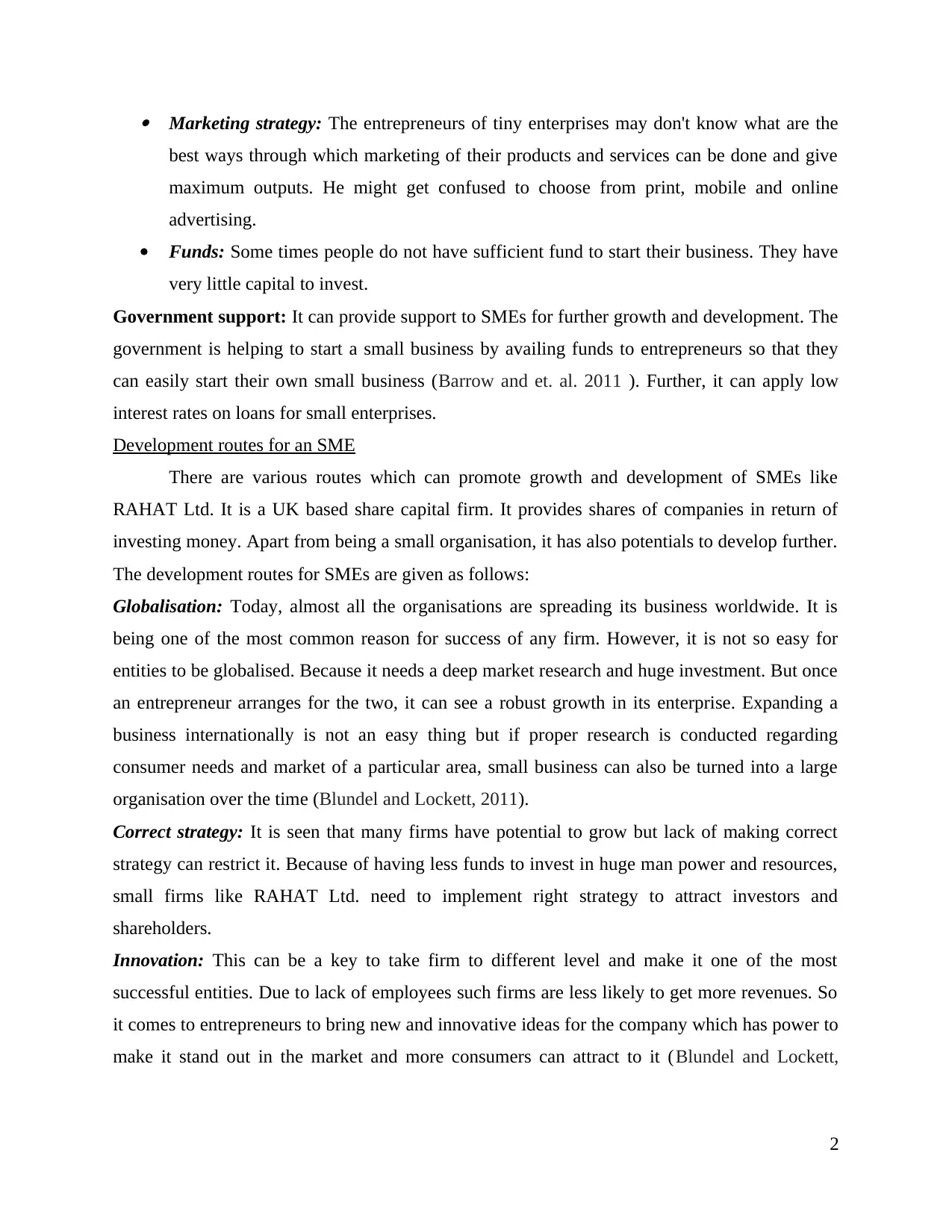
Marketing strategy: The entrepreneurs of tiny enterprises may don't know what are the
best ways through which marketing of their products and services can be done and give
maximum outputs. He might get confused to choose from print, mobile and online
advertising.
Funds: Some times people do not have sufficient fund to start their business. They have
very little capital to invest.
Government support: It can provide support to SMEs for further growth and development. The
government is helping to start a small business by availing funds to entrepreneurs so that they
can easily start their own small business (Barrow and et. al. 2011 ). Further, it can apply low
interest rates on loans for small enterprises.
Development routes for an SME
There are various routes which can promote growth and development of SMEs like
RAHAT Ltd. It is a UK based share capital firm. It provides shares of companies in return of
investing money. Apart from being a small organisation, it has also potentials to develop further.
The development routes for SMEs are given as follows:
Globalisation: Today, almost all the organisations are spreading its business worldwide. It is
being one of the most common reason for success of any firm. However, it is not so easy for
entities to be globalised. Because it needs a deep market research and huge investment. But once
an entrepreneur arranges for the two, it can see a robust growth in its enterprise. Expanding a
business internationally is not an easy thing but if proper research is conducted regarding
consumer needs and market of a particular area, small business can also be turned into a large
organisation over the time (Blundel and Lockett, 2011).
Correct strategy: It is seen that many firms have potential to grow but lack of making correct
strategy can restrict it. Because of having less funds to invest in huge man power and resources,
small firms like RAHAT Ltd. need to implement right strategy to attract investors and
shareholders.
Innovation: This can be a key to take firm to different level and make it one of the most
successful entities. Due to lack of employees such firms are less likely to get more revenues. So
it comes to entrepreneurs to bring new and innovative ideas for the company which has power to
make it stand out in the market and more consumers can attract to it (Blundel and Lockett,
2
best ways through which marketing of their products and services can be done and give
maximum outputs. He might get confused to choose from print, mobile and online
advertising.
Funds: Some times people do not have sufficient fund to start their business. They have
very little capital to invest.
Government support: It can provide support to SMEs for further growth and development. The
government is helping to start a small business by availing funds to entrepreneurs so that they
can easily start their own small business (Barrow and et. al. 2011 ). Further, it can apply low
interest rates on loans for small enterprises.
Development routes for an SME
There are various routes which can promote growth and development of SMEs like
RAHAT Ltd. It is a UK based share capital firm. It provides shares of companies in return of
investing money. Apart from being a small organisation, it has also potentials to develop further.
The development routes for SMEs are given as follows:
Globalisation: Today, almost all the organisations are spreading its business worldwide. It is
being one of the most common reason for success of any firm. However, it is not so easy for
entities to be globalised. Because it needs a deep market research and huge investment. But once
an entrepreneur arranges for the two, it can see a robust growth in its enterprise. Expanding a
business internationally is not an easy thing but if proper research is conducted regarding
consumer needs and market of a particular area, small business can also be turned into a large
organisation over the time (Blundel and Lockett, 2011).
Correct strategy: It is seen that many firms have potential to grow but lack of making correct
strategy can restrict it. Because of having less funds to invest in huge man power and resources,
small firms like RAHAT Ltd. need to implement right strategy to attract investors and
shareholders.
Innovation: This can be a key to take firm to different level and make it one of the most
successful entities. Due to lack of employees such firms are less likely to get more revenues. So
it comes to entrepreneurs to bring new and innovative ideas for the company which has power to
make it stand out in the market and more consumers can attract to it (Blundel and Lockett,
2
Paraphrase This Document
Need a fresh take? Get an instant paraphrase of this document with our AI Paraphraser
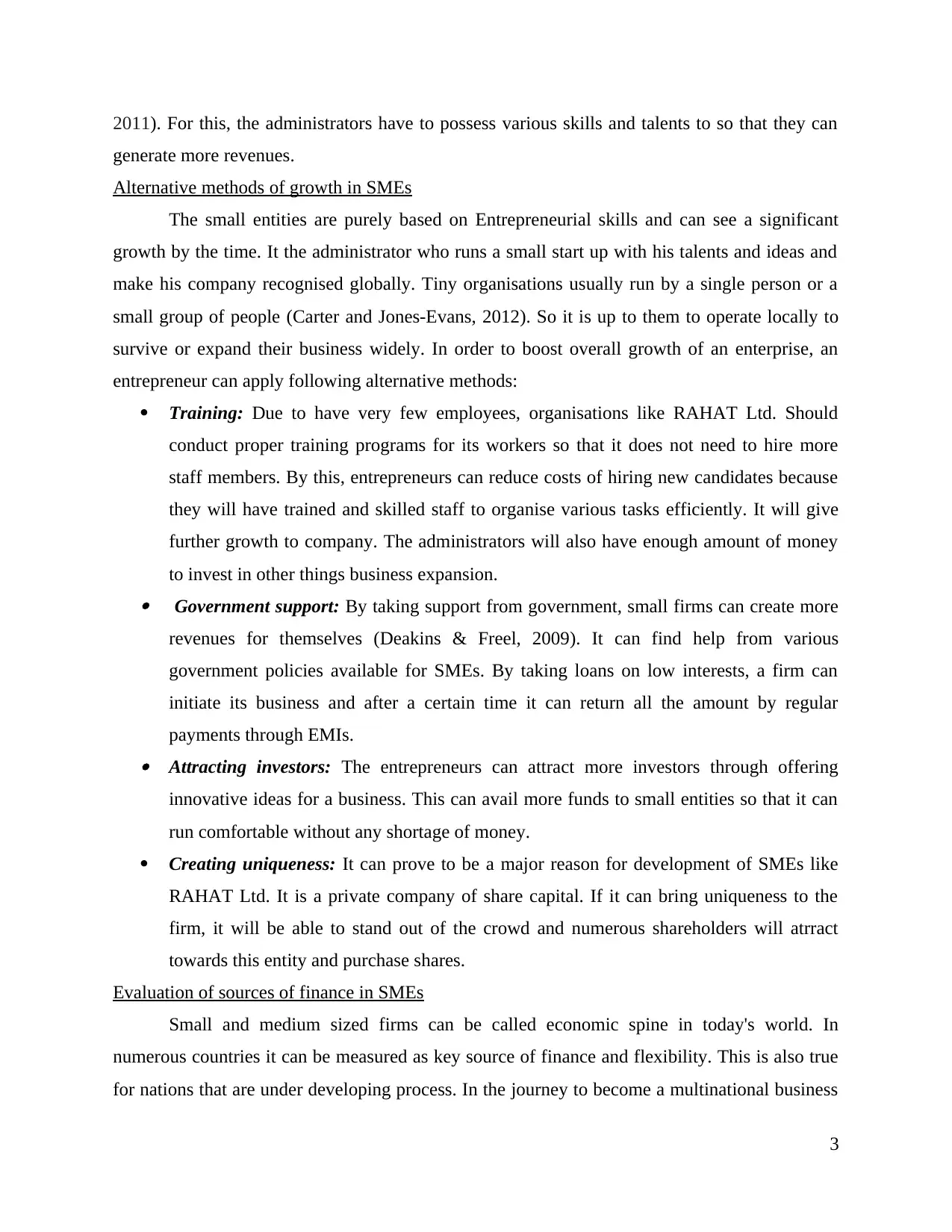
2011). For this, the administrators have to possess various skills and talents to so that they can
generate more revenues.
Alternative methods of growth in SMEs
The small entities are purely based on Entrepreneurial skills and can see a significant
growth by the time. It the administrator who runs a small start up with his talents and ideas and
make his company recognised globally. Tiny organisations usually run by a single person or a
small group of people (Carter and Jones-Evans, 2012). So it is up to them to operate locally to
survive or expand their business widely. In order to boost overall growth of an enterprise, an
entrepreneur can apply following alternative methods:
Training: Due to have very few employees, organisations like RAHAT Ltd. Should
conduct proper training programs for its workers so that it does not need to hire more
staff members. By this, entrepreneurs can reduce costs of hiring new candidates because
they will have trained and skilled staff to organise various tasks efficiently. It will give
further growth to company. The administrators will also have enough amount of money
to invest in other things business expansion. Government support: By taking support from government, small firms can create more
revenues for themselves (Deakins & Freel, 2009). It can find help from various
government policies available for SMEs. By taking loans on low interests, a firm can
initiate its business and after a certain time it can return all the amount by regular
payments through EMIs. Attracting investors: The entrepreneurs can attract more investors through offering
innovative ideas for a business. This can avail more funds to small entities so that it can
run comfortable without any shortage of money.
Creating uniqueness: It can prove to be a major reason for development of SMEs like
RAHAT Ltd. It is a private company of share capital. If it can bring uniqueness to the
firm, it will be able to stand out of the crowd and numerous shareholders will atrract
towards this entity and purchase shares.
Evaluation of sources of finance in SMEs
Small and medium sized firms can be called economic spine in today's world. In
numerous countries it can be measured as key source of finance and flexibility. This is also true
for nations that are under developing process. In the journey to become a multinational business
3
generate more revenues.
Alternative methods of growth in SMEs
The small entities are purely based on Entrepreneurial skills and can see a significant
growth by the time. It the administrator who runs a small start up with his talents and ideas and
make his company recognised globally. Tiny organisations usually run by a single person or a
small group of people (Carter and Jones-Evans, 2012). So it is up to them to operate locally to
survive or expand their business widely. In order to boost overall growth of an enterprise, an
entrepreneur can apply following alternative methods:
Training: Due to have very few employees, organisations like RAHAT Ltd. Should
conduct proper training programs for its workers so that it does not need to hire more
staff members. By this, entrepreneurs can reduce costs of hiring new candidates because
they will have trained and skilled staff to organise various tasks efficiently. It will give
further growth to company. The administrators will also have enough amount of money
to invest in other things business expansion. Government support: By taking support from government, small firms can create more
revenues for themselves (Deakins & Freel, 2009). It can find help from various
government policies available for SMEs. By taking loans on low interests, a firm can
initiate its business and after a certain time it can return all the amount by regular
payments through EMIs. Attracting investors: The entrepreneurs can attract more investors through offering
innovative ideas for a business. This can avail more funds to small entities so that it can
run comfortable without any shortage of money.
Creating uniqueness: It can prove to be a major reason for development of SMEs like
RAHAT Ltd. It is a private company of share capital. If it can bring uniqueness to the
firm, it will be able to stand out of the crowd and numerous shareholders will atrract
towards this entity and purchase shares.
Evaluation of sources of finance in SMEs
Small and medium sized firms can be called economic spine in today's world. In
numerous countries it can be measured as key source of finance and flexibility. This is also true
for nations that are under developing process. In the journey to become a multinational business
3
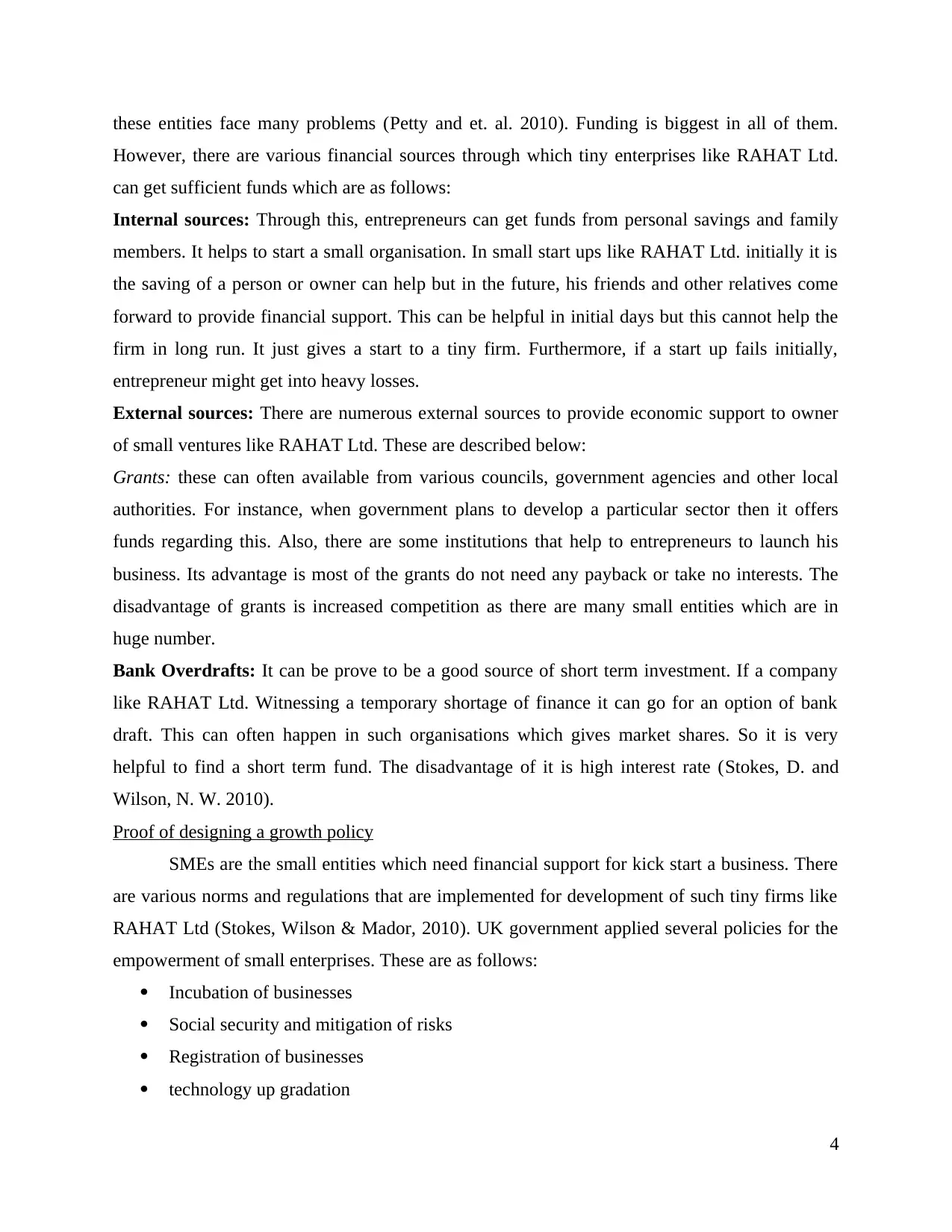
these entities face many problems (Petty and et. al. 2010). Funding is biggest in all of them.
However, there are various financial sources through which tiny enterprises like RAHAT Ltd.
can get sufficient funds which are as follows:
Internal sources: Through this, entrepreneurs can get funds from personal savings and family
members. It helps to start a small organisation. In small start ups like RAHAT Ltd. initially it is
the saving of a person or owner can help but in the future, his friends and other relatives come
forward to provide financial support. This can be helpful in initial days but this cannot help the
firm in long run. It just gives a start to a tiny firm. Furthermore, if a start up fails initially,
entrepreneur might get into heavy losses.
External sources: There are numerous external sources to provide economic support to owner
of small ventures like RAHAT Ltd. These are described below:
Grants: these can often available from various councils, government agencies and other local
authorities. For instance, when government plans to develop a particular sector then it offers
funds regarding this. Also, there are some institutions that help to entrepreneurs to launch his
business. Its advantage is most of the grants do not need any payback or take no interests. The
disadvantage of grants is increased competition as there are many small entities which are in
huge number.
Bank Overdrafts: It can be prove to be a good source of short term investment. If a company
like RAHAT Ltd. Witnessing a temporary shortage of finance it can go for an option of bank
draft. This can often happen in such organisations which gives market shares. So it is very
helpful to find a short term fund. The disadvantage of it is high interest rate (Stokes, D. and
Wilson, N. W. 2010).
Proof of designing a growth policy
SMEs are the small entities which need financial support for kick start a business. There
are various norms and regulations that are implemented for development of such tiny firms like
RAHAT Ltd (Stokes, Wilson & Mador, 2010). UK government applied several policies for the
empowerment of small enterprises. These are as follows:
Incubation of businesses
Social security and mitigation of risks
Registration of businesses
technology up gradation
4
However, there are various financial sources through which tiny enterprises like RAHAT Ltd.
can get sufficient funds which are as follows:
Internal sources: Through this, entrepreneurs can get funds from personal savings and family
members. It helps to start a small organisation. In small start ups like RAHAT Ltd. initially it is
the saving of a person or owner can help but in the future, his friends and other relatives come
forward to provide financial support. This can be helpful in initial days but this cannot help the
firm in long run. It just gives a start to a tiny firm. Furthermore, if a start up fails initially,
entrepreneur might get into heavy losses.
External sources: There are numerous external sources to provide economic support to owner
of small ventures like RAHAT Ltd. These are described below:
Grants: these can often available from various councils, government agencies and other local
authorities. For instance, when government plans to develop a particular sector then it offers
funds regarding this. Also, there are some institutions that help to entrepreneurs to launch his
business. Its advantage is most of the grants do not need any payback or take no interests. The
disadvantage of grants is increased competition as there are many small entities which are in
huge number.
Bank Overdrafts: It can be prove to be a good source of short term investment. If a company
like RAHAT Ltd. Witnessing a temporary shortage of finance it can go for an option of bank
draft. This can often happen in such organisations which gives market shares. So it is very
helpful to find a short term fund. The disadvantage of it is high interest rate (Stokes, D. and
Wilson, N. W. 2010).
Proof of designing a growth policy
SMEs are the small entities which need financial support for kick start a business. There
are various norms and regulations that are implemented for development of such tiny firms like
RAHAT Ltd (Stokes, Wilson & Mador, 2010). UK government applied several policies for the
empowerment of small enterprises. These are as follows:
Incubation of businesses
Social security and mitigation of risks
Registration of businesses
technology up gradation
4
⊘ This is a preview!⊘
Do you want full access?
Subscribe today to unlock all pages.

Trusted by 1+ million students worldwide
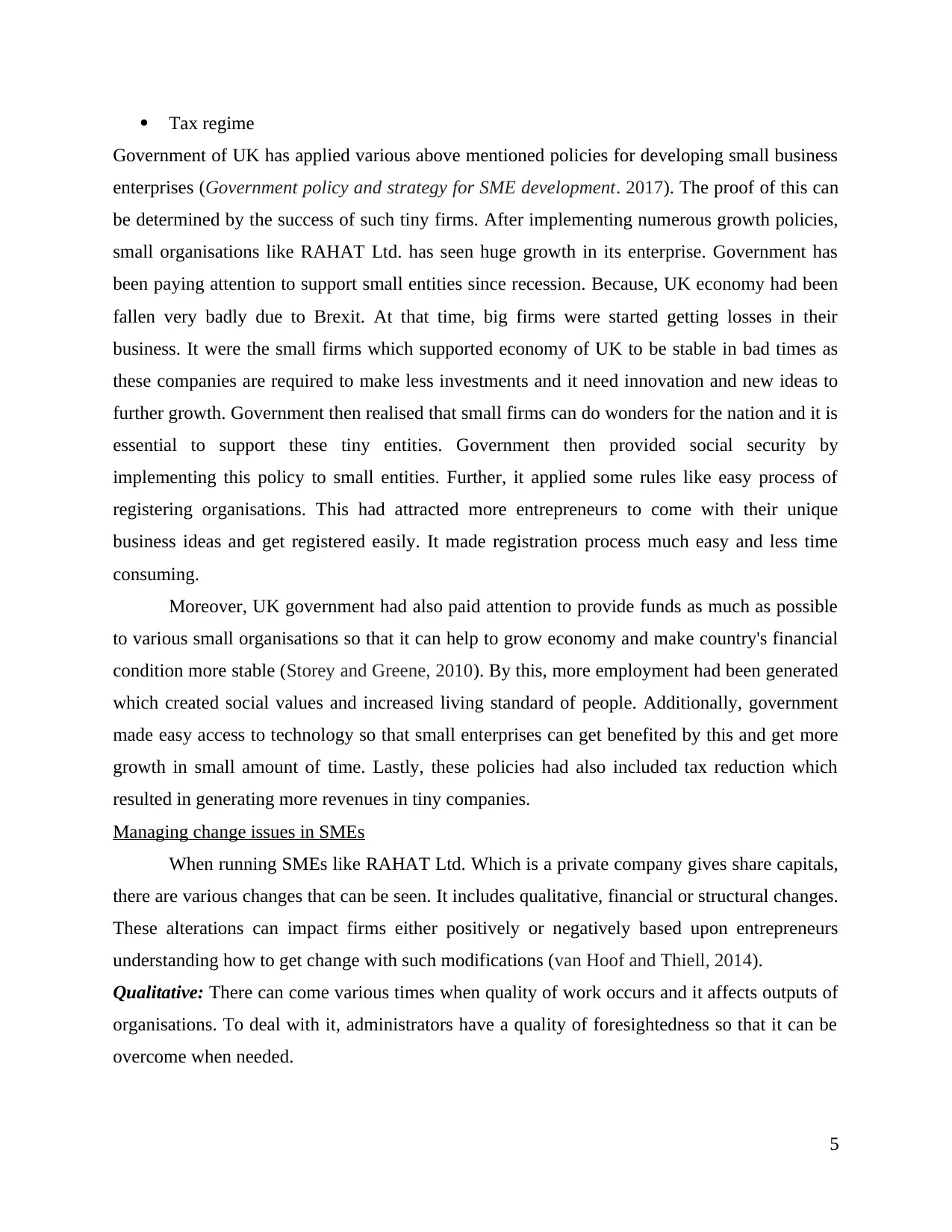
Tax regime
Government of UK has applied various above mentioned policies for developing small business
enterprises (Government policy and strategy for SME development. 2017). The proof of this can
be determined by the success of such tiny firms. After implementing numerous growth policies,
small organisations like RAHAT Ltd. has seen huge growth in its enterprise. Government has
been paying attention to support small entities since recession. Because, UK economy had been
fallen very badly due to Brexit. At that time, big firms were started getting losses in their
business. It were the small firms which supported economy of UK to be stable in bad times as
these companies are required to make less investments and it need innovation and new ideas to
further growth. Government then realised that small firms can do wonders for the nation and it is
essential to support these tiny entities. Government then provided social security by
implementing this policy to small entities. Further, it applied some rules like easy process of
registering organisations. This had attracted more entrepreneurs to come with their unique
business ideas and get registered easily. It made registration process much easy and less time
consuming.
Moreover, UK government had also paid attention to provide funds as much as possible
to various small organisations so that it can help to grow economy and make country's financial
condition more stable (Storey and Greene, 2010). By this, more employment had been generated
which created social values and increased living standard of people. Additionally, government
made easy access to technology so that small enterprises can get benefited by this and get more
growth in small amount of time. Lastly, these policies had also included tax reduction which
resulted in generating more revenues in tiny companies.
Managing change issues in SMEs
When running SMEs like RAHAT Ltd. Which is a private company gives share capitals,
there are various changes that can be seen. It includes qualitative, financial or structural changes.
These alterations can impact firms either positively or negatively based upon entrepreneurs
understanding how to get change with such modifications (van Hoof and Thiell, 2014).
Qualitative: There can come various times when quality of work occurs and it affects outputs of
organisations. To deal with it, administrators have a quality of foresightedness so that it can be
overcome when needed.
5
Government of UK has applied various above mentioned policies for developing small business
enterprises (Government policy and strategy for SME development. 2017). The proof of this can
be determined by the success of such tiny firms. After implementing numerous growth policies,
small organisations like RAHAT Ltd. has seen huge growth in its enterprise. Government has
been paying attention to support small entities since recession. Because, UK economy had been
fallen very badly due to Brexit. At that time, big firms were started getting losses in their
business. It were the small firms which supported economy of UK to be stable in bad times as
these companies are required to make less investments and it need innovation and new ideas to
further growth. Government then realised that small firms can do wonders for the nation and it is
essential to support these tiny entities. Government then provided social security by
implementing this policy to small entities. Further, it applied some rules like easy process of
registering organisations. This had attracted more entrepreneurs to come with their unique
business ideas and get registered easily. It made registration process much easy and less time
consuming.
Moreover, UK government had also paid attention to provide funds as much as possible
to various small organisations so that it can help to grow economy and make country's financial
condition more stable (Storey and Greene, 2010). By this, more employment had been generated
which created social values and increased living standard of people. Additionally, government
made easy access to technology so that small enterprises can get benefited by this and get more
growth in small amount of time. Lastly, these policies had also included tax reduction which
resulted in generating more revenues in tiny companies.
Managing change issues in SMEs
When running SMEs like RAHAT Ltd. Which is a private company gives share capitals,
there are various changes that can be seen. It includes qualitative, financial or structural changes.
These alterations can impact firms either positively or negatively based upon entrepreneurs
understanding how to get change with such modifications (van Hoof and Thiell, 2014).
Qualitative: There can come various times when quality of work occurs and it affects outputs of
organisations. To deal with it, administrators have a quality of foresightedness so that it can be
overcome when needed.
5
Paraphrase This Document
Need a fresh take? Get an instant paraphrase of this document with our AI Paraphraser
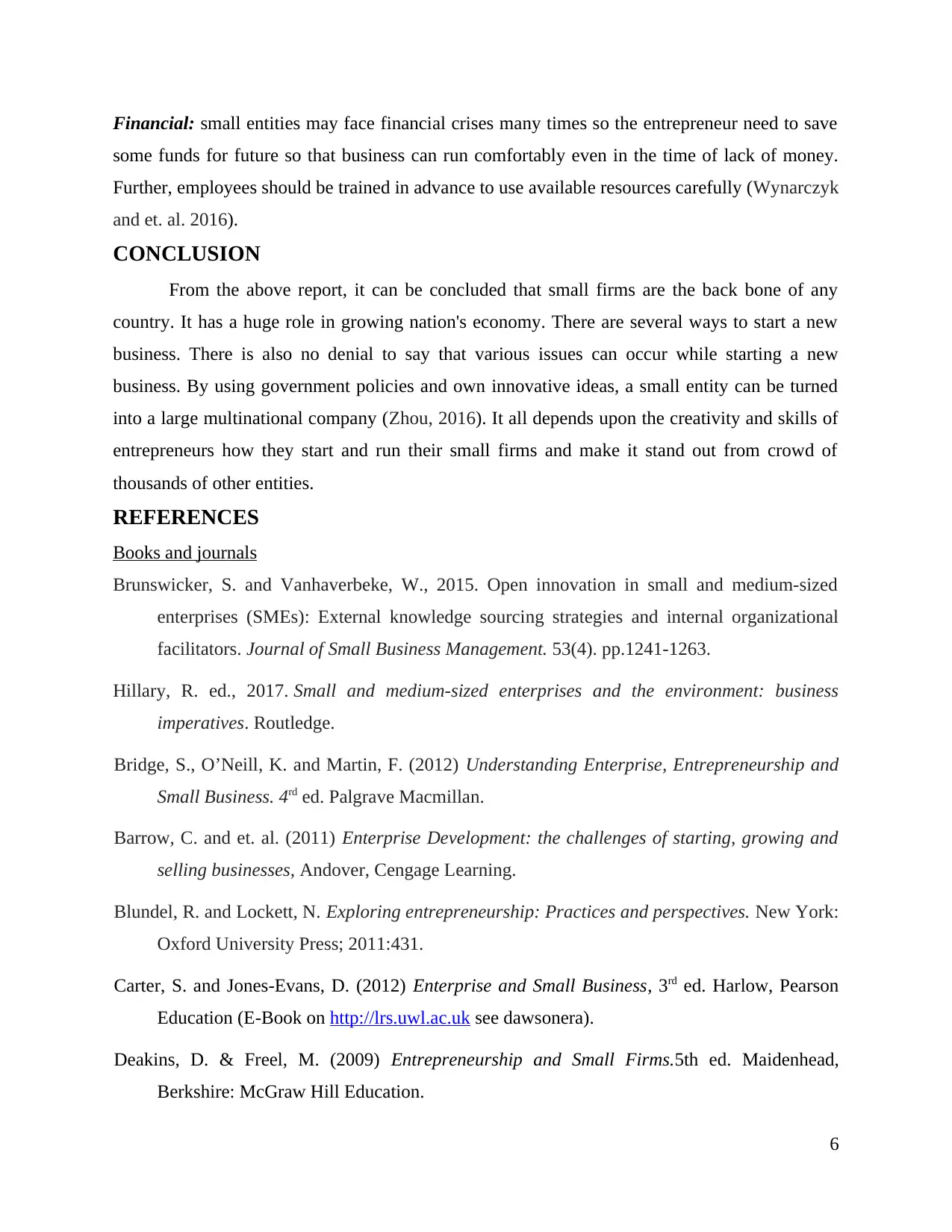
Financial: small entities may face financial crises many times so the entrepreneur need to save
some funds for future so that business can run comfortably even in the time of lack of money.
Further, employees should be trained in advance to use available resources carefully (Wynarczyk
and et. al. 2016).
CONCLUSION
From the above report, it can be concluded that small firms are the back bone of any
country. It has a huge role in growing nation's economy. There are several ways to start a new
business. There is also no denial to say that various issues can occur while starting a new
business. By using government policies and own innovative ideas, a small entity can be turned
into a large multinational company (Zhou, 2016). It all depends upon the creativity and skills of
entrepreneurs how they start and run their small firms and make it stand out from crowd of
thousands of other entities.
REFERENCES
Books and journals
Brunswicker, S. and Vanhaverbeke, W., 2015. Open innovation in small and medium‐sized
enterprises (SMEs): External knowledge sourcing strategies and internal organizational
facilitators. Journal of Small Business Management. 53(4). pp.1241-1263.
Hillary, R. ed., 2017. Small and medium-sized enterprises and the environment: business
imperatives. Routledge.
Bridge, S., O’Neill, K. and Martin, F. (2012) Understanding Enterprise, Entrepreneurship and
Small Business. 4rd ed. Palgrave Macmillan.
Barrow, C. and et. al. (2011) Enterprise Development: the challenges of starting, growing and
selling businesses, Andover, Cengage Learning.
Blundel, R. and Lockett, N. Exploring entrepreneurship: Practices and perspectives. New York:
Oxford University Press; 2011:431.
Carter, S. and Jones-Evans, D. (2012) Enterprise and Small Business, 3rd ed. Harlow, Pearson
Education (E-Book on http://lrs.uwl.ac.uk see dawsonera).
Deakins, D. & Freel, M. (2009) Entrepreneurship and Small Firms.5th ed. Maidenhead,
Berkshire: McGraw Hill Education.
6
some funds for future so that business can run comfortably even in the time of lack of money.
Further, employees should be trained in advance to use available resources carefully (Wynarczyk
and et. al. 2016).
CONCLUSION
From the above report, it can be concluded that small firms are the back bone of any
country. It has a huge role in growing nation's economy. There are several ways to start a new
business. There is also no denial to say that various issues can occur while starting a new
business. By using government policies and own innovative ideas, a small entity can be turned
into a large multinational company (Zhou, 2016). It all depends upon the creativity and skills of
entrepreneurs how they start and run their small firms and make it stand out from crowd of
thousands of other entities.
REFERENCES
Books and journals
Brunswicker, S. and Vanhaverbeke, W., 2015. Open innovation in small and medium‐sized
enterprises (SMEs): External knowledge sourcing strategies and internal organizational
facilitators. Journal of Small Business Management. 53(4). pp.1241-1263.
Hillary, R. ed., 2017. Small and medium-sized enterprises and the environment: business
imperatives. Routledge.
Bridge, S., O’Neill, K. and Martin, F. (2012) Understanding Enterprise, Entrepreneurship and
Small Business. 4rd ed. Palgrave Macmillan.
Barrow, C. and et. al. (2011) Enterprise Development: the challenges of starting, growing and
selling businesses, Andover, Cengage Learning.
Blundel, R. and Lockett, N. Exploring entrepreneurship: Practices and perspectives. New York:
Oxford University Press; 2011:431.
Carter, S. and Jones-Evans, D. (2012) Enterprise and Small Business, 3rd ed. Harlow, Pearson
Education (E-Book on http://lrs.uwl.ac.uk see dawsonera).
Deakins, D. & Freel, M. (2009) Entrepreneurship and Small Firms.5th ed. Maidenhead,
Berkshire: McGraw Hill Education.
6
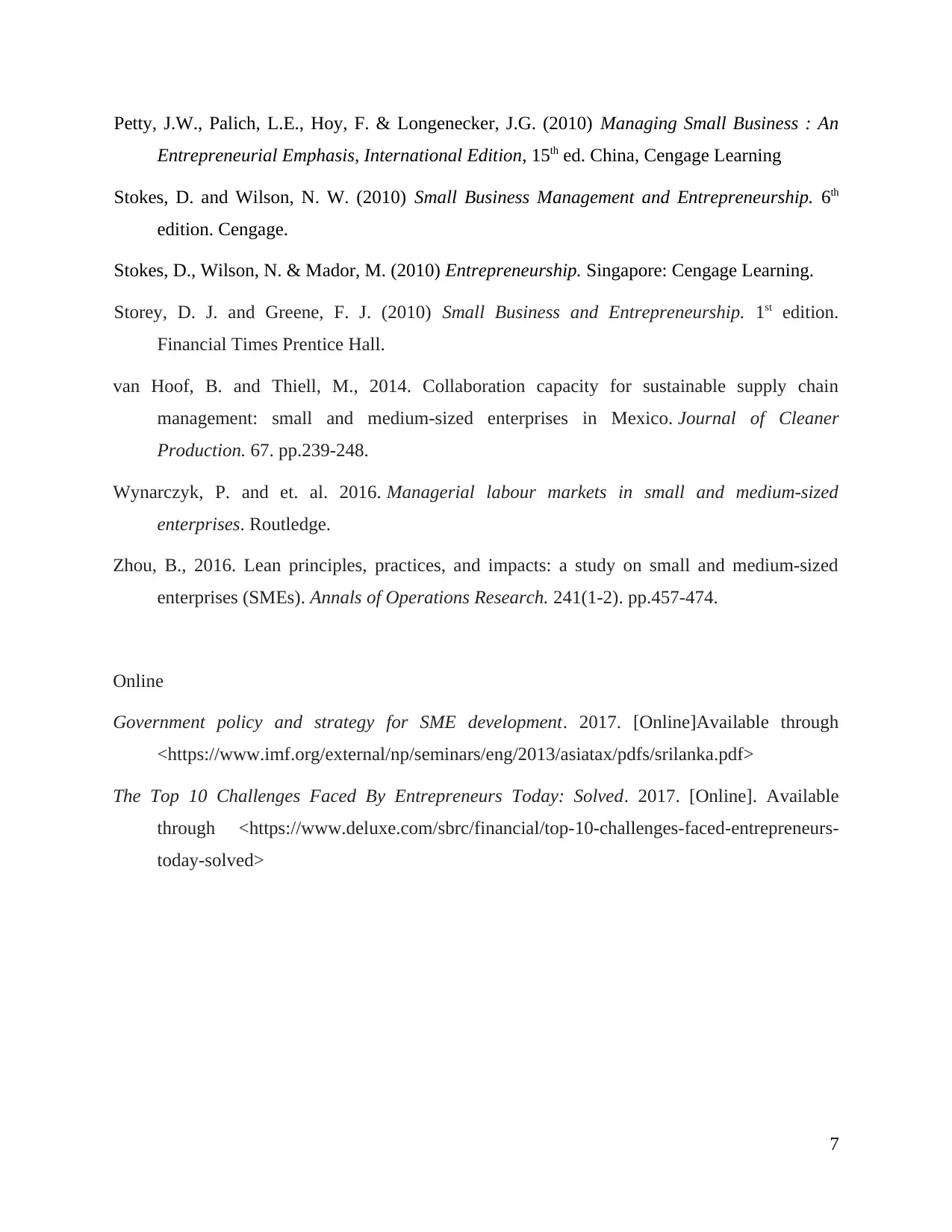
Petty, J.W., Palich, L.E., Hoy, F. & Longenecker, J.G. (2010) Managing Small Business : An
Entrepreneurial Emphasis, International Edition, 15th ed. China, Cengage Learning
Stokes, D. and Wilson, N. W. (2010) Small Business Management and Entrepreneurship. 6th
edition. Cengage.
Stokes, D., Wilson, N. & Mador, M. (2010) Entrepreneurship. Singapore: Cengage Learning.
Storey, D. J. and Greene, F. J. (2010) Small Business and Entrepreneurship. 1st edition.
Financial Times Prentice Hall.
van Hoof, B. and Thiell, M., 2014. Collaboration capacity for sustainable supply chain
management: small and medium-sized enterprises in Mexico. Journal of Cleaner
Production. 67. pp.239-248.
Wynarczyk, P. and et. al. 2016. Managerial labour markets in small and medium-sized
enterprises. Routledge.
Zhou, B., 2016. Lean principles, practices, and impacts: a study on small and medium-sized
enterprises (SMEs). Annals of Operations Research. 241(1-2). pp.457-474.
Online
Government policy and strategy for SME development. 2017. [Online]Available through
<https://www.imf.org/external/np/seminars/eng/2013/asiatax/pdfs/srilanka.pdf>
The Top 10 Challenges Faced By Entrepreneurs Today: Solved. 2017. [Online]. Available
through <https://www.deluxe.com/sbrc/financial/top-10-challenges-faced-entrepreneurs-
today-solved>
7
Entrepreneurial Emphasis, International Edition, 15th ed. China, Cengage Learning
Stokes, D. and Wilson, N. W. (2010) Small Business Management and Entrepreneurship. 6th
edition. Cengage.
Stokes, D., Wilson, N. & Mador, M. (2010) Entrepreneurship. Singapore: Cengage Learning.
Storey, D. J. and Greene, F. J. (2010) Small Business and Entrepreneurship. 1st edition.
Financial Times Prentice Hall.
van Hoof, B. and Thiell, M., 2014. Collaboration capacity for sustainable supply chain
management: small and medium-sized enterprises in Mexico. Journal of Cleaner
Production. 67. pp.239-248.
Wynarczyk, P. and et. al. 2016. Managerial labour markets in small and medium-sized
enterprises. Routledge.
Zhou, B., 2016. Lean principles, practices, and impacts: a study on small and medium-sized
enterprises (SMEs). Annals of Operations Research. 241(1-2). pp.457-474.
Online
Government policy and strategy for SME development. 2017. [Online]Available through
<https://www.imf.org/external/np/seminars/eng/2013/asiatax/pdfs/srilanka.pdf>
The Top 10 Challenges Faced By Entrepreneurs Today: Solved. 2017. [Online]. Available
through <https://www.deluxe.com/sbrc/financial/top-10-challenges-faced-entrepreneurs-
today-solved>
7
⊘ This is a preview!⊘
Do you want full access?
Subscribe today to unlock all pages.

Trusted by 1+ million students worldwide
1 out of 9
Related Documents
Your All-in-One AI-Powered Toolkit for Academic Success.
+13062052269
info@desklib.com
Available 24*7 on WhatsApp / Email
![[object Object]](/_next/static/media/star-bottom.7253800d.svg)
Unlock your academic potential
Copyright © 2020–2025 A2Z Services. All Rights Reserved. Developed and managed by ZUCOL.




